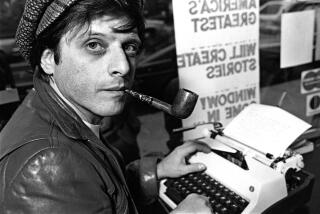Father of Invention
Was it genius that powered Edison’s inventions of the incandescent lightbulb, the phonograph and the first motion picture? Or something stickier?
Let’s go directly to the source. We give you Thomas Alva Edison--unplugged: “Genius? I always like to say that it’s 1% inspiration and 99% perspiration. Yes sir, there’s no substitute for good, old-fashioned stick-to-it-iveness.”
It’s no mirage. Clad in a dapper suit, his snowy hair combed away from his lined brow, Thomas Alva Edison (1847-1931) has been brought back to life by Drew Wilson, a 72-year-old Mission Viejo retiree with such admiration and knowledge of the brilliant inventor-businessman that he’s made a second career sharing it with schoolchildren across the country.
On Saturday, Wilson portrays Edison in two programs at the Children’s Museum at La Habra: “The Thomas Edison Invention Factory” and “Contributions of Blacks in Science,” an overview of leading black scientists, with Edison as host.
Both audience-participation programs are targeted to third-graders and up but accessible to a wide range of ages and interests, said Wilson. The program, the second of three this summer at the museum underwritten by Southern California Edison, repeats Aug. 23 and is free with museum admission.
For the record, Wilson, who makes 30 to 40 appearances each year under the sponsorship of Edison, isn’t the only local who wants to get kids charged up about the Wizard of Menlo Park, N.J.
At Knott’s Berry Farm, for example, a gent named Peter Small portrays the inventor at the Thomas A. Edison Inventor’s Workshop, an interactive exhibit that the power company opened in 1992. (Wilson periodically makes guest appearances at that venue as well.)
But he certainly is one of the most enthusiastic Edisons around. A former graphic arts teacher and sometime actor (he says he holds SAG and AFTRA cards and lists a small role in the Chris Farley film “Black Sheep” among his credits), Wilson says he doesn’t just want to fill kids’ heads with a laundry list of Edison’s accomplishments.
Instead, he wants to instill in them the spirit that he thinks powered those inventions.
“I’m trying to inject them with enthusiasm, a sense of fun and the belief that you can do anything if you make up your mind and stick to it,” Wilson said. “It’s a message that’s very much needed today [because] a lot of kids have been led to expect instant success. You’ve got to hang on to your ideas and keep working.”
It was tenacity, even in the face of failure, that turned a small boy from Milan, Ohio, into one of the pivotal figures in modern history. In fact, Wilson goes out of his way to point out one or two of Edison’s relative flops to kids, just to show them that even failure can be turned to their advantage.
*
In the 1890s, for example, Edison sank $1 million into developing equipment to process iron ore, only to be skunked by the discovery of high-grade ore in Minnesota that was of better quality and cheaper to process.
Down the road, however, his foresight and skills as a businessman turned that loss to a gain by salvaging some of that equipment to mass produce cement, a product he then promoted by instigating the use of concrete in buildings and even furniture.
Edison’s genius as an inventor was rivaled only by his practicality, said Wilson. After some false starts, Edison learned to thoroughly research his market before introducing a new design or device, then he followed through by developing products the public would want or need.
“While he was developing the electric bulb, he researched how much gaslight cost and realized he had to come up an electric bulb that would cost less,” said Wilson. Edison helped ensure that his product could be economically used by helping to construct power plants in major cities, he added, and investing with his associates in companies that developed and built products that used his inventions (a collaboration that would become the General Electric in 1892).
*
Wilson’s physical resemblance to Edison is remarkable and his knowledge of the man’s life and accomplishments even more so. Although he’s spent nearly 15 years portraying Edison, he, like the inventor, never stops researching and refining his product.
He devours books and articles about Edison, and, every year for the past seven, he’s spent several days portraying the inventor and trolling the Edison archives at the annual Edison Days at the West Orange, N.J., research laboratory and home, now operated as a historic site by the National Park Service.
While taping a cameo as Edison for cable’s History Channel, he bumped into Mickey Rooney, who once played the young Edison on film.
“He did a double take when he saw me,” recalled Wilson with a laugh. “I think I really took him back for a minute.”
BE THERE
* Drew Wilson portrays Thomas Edison in “The Thomas Edison Invention Factory” on Saturday at 11 a.m. and “The Contribution of Blacks in Science” at 1 p.m. at the Children’s Museum at La Habra, 301 S. Euclid St. Performances are free with museum admission of $4; children under 2 are free. “Thomas Edison Invention Factory” repeats Aug. 23 at noon. (562) 905-9793.
More to Read
The biggest entertainment stories
Get our big stories about Hollywood, film, television, music, arts, culture and more right in your inbox as soon as they publish.
You may occasionally receive promotional content from the Los Angeles Times.










